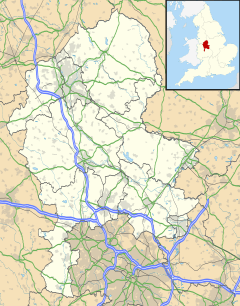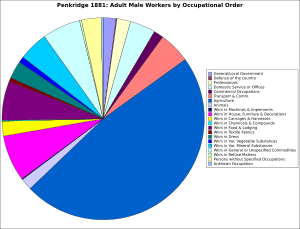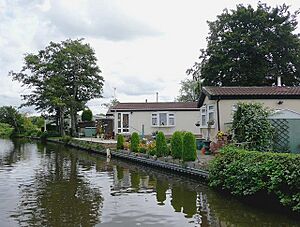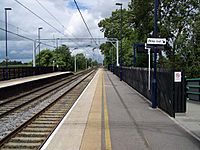Penkridge facts for kids
Quick facts for kids Penkridge |
|
|---|---|
| Village and civil parish | |
|
Clockwise from top: Penkridge Festival Garden, Market Street, Viaduct, Lock on the Staffordshire and Worcestershire Canal and St Michael and All Angels Church |
|
| Population | 8,526 (2011) |
| OS grid reference | SJ922141 |
| District |
|
| Shire county | |
| Region | |
| Country | England |
| Sovereign state | United Kingdom |
| Post town | STAFFORD |
| Postcode district | ST19 |
| Dialling code | 01785 |
| Police | Staffordshire |
| Fire | Staffordshire |
| Ambulance | West Midlands |
| EU Parliament | West Midlands |
| UK Parliament |
|
Penkridge (/ˈpɛŋkrɪdʒ/ PENG-krij) is a village and civil parish in South Staffordshire District in Staffordshire, England. It is located south of Stafford and north of Wolverhampton.
In the Middle Ages, the richest place in Penkridge was its collegiate church. This church building is still the tallest structure in the village centre. Penkridge is also crossed by the M6 motorway and has its own railway station. The Penkridge Viaduct and the Staffordshire and Worcestershire Canal are also important landmarks.
Contents
About Penkridge
Penkridge is a village and civil parish. Over the centuries, its boundaries have changed a lot. In the past, it included other smaller areas like Coppenhall and Dunston. Today, Penkridge is made up of several smaller settlements that have joined together.
Where is Penkridge?
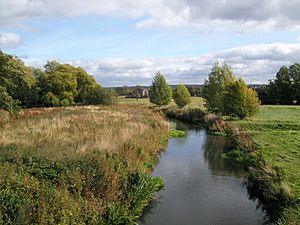
Penkridge is in the South Staffordshire district, within the Staffordshire county. It sits between Stafford, which is about 8 km (5 miles) north, and Wolverhampton, about 16 km (10 miles) south. Most of the village is on the east side of the River Penk.
Penkridge has always been connected to major travel routes. It was on an old medieval road between Stafford and Worcester. This road later became part of the A449 road. South of Penkridge, this road crosses Watling Street, which is now the A5 road. This ancient Roman road linked London to Chester and Wales. In 1770, the Staffordshire and Worcestershire Canal was built through the village. Today, the M6 motorway, a main route from London to the north-west, passes by Penkridge.
What's in a Name?
Many people think the village name "Penkridge" comes from the River Penk. However, it's actually the other way around! The village's name came first, and the river was named after the village.
The Romans built a fort nearby and called it Pennocrucium. The name Penkridge likely comes from an old Celtic word, penn-crug. This means "the head (or end) of the ridge" or "chief hill or mound." This suggests there was an important hill or mound near the ancient settlement.
How Penkridge is Governed
Penkridge is part of the Stone, Great Wyrley and Penkridge parliament constituency. This means people in Penkridge vote for a Member of Parliament (MP) to represent them in the national government.
Locally, Penkridge has two levels of government:
- The District Council is South Staffordshire Council, based in Codsall. Penkridge is divided into three areas for these elections.
- The County Council is Staffordshire. Penkridge is one electoral area for the county council.
Currently, all the local councillors for Penkridge belong to the Conservative Party.
History of Penkridge
Early Times
People have lived in the Penkridge area since the Bronze Age. An ancient burial mound (barrow) was found at Rowley Hill. The first important settlement was near where the River Penk met the Roman road called Watling Street (today's A5). This was a Roman settlement called Pennocrucium, but it was not exactly where the modern village of Penkridge is now.
Medieval Penkridge
Anglo-Saxon Beginnings
The village of Penkridge itself started in the early Middle Ages, when the area was part of a kingdom called Mercia. We don't know the exact date it was founded. In 958, King Edgar called it a "famous place," so it was already important back then. It's believed that King Eadred (946-955), King Edgar's uncle, founded the church of St. Michael in Penkridge.
The Important Church
Penkridge's church was very important from Anglo-Saxon times onwards. It had a special status:
- It was a collegiate church: This meant it was served by a group of priests called a chapter, not monks.
- It was a chapel royal: This meant it was a special church for the king or queen to pray in. This made it independent from the local Bishop of Lichfield.
- It was run like a cathedral chapter, with a Dean in charge.
- From 1226, the Archbishop of Dublin became the head (Dean) of Penkridge church.
The collegiate church was the most important local building for most of Penkridge's history. It was powerful and looked impressive. Everyone in the parish had to be buried there, which cost money. Its area also defined the Penkridge parish, which was the main local government area for a long time.
Life in the Forest
In medieval times, large areas around Penkridge were part of the Royal Forest of Cank (now Cannock Chase). Special "Forest Law" was used to protect the king's hunting grounds. This law made it hard for people in South Staffordshire to grow economically. However, over time, these laws became less strict. This allowed Penkridge to grow. Local people started clearing trees to create new fields. Penkridge also gained the right to hold an annual fair and a weekly market.
Manors and Important Families
Medieval Penkridge was organized into manors. A manor was a large estate with its own lord, who had power over the people living there. The most important manor was Penkridge Manor itself.
The Church also owned a lot of land. St. Michael's college had its own manor and other lands. Some manors belonged to monasteries, like Burton Abbey.
By the late 14th century, the lords of Penkridge manor had special rights, even the power to give the death penalty.
Around 1500, the Littleton family became important in Penkridge. They gained control of Pillaton and built Pillaton Hall. They also leased most of the church's lands and built a family chapel in the church. They became the most important local landed gentry (wealthy landowners).
Farming and Trade
Much of the Penkridge area was farmed using the open field system. Farmers grew crops like wheat, barley, and oats. They also kept cattle and sheep.
In the early Middle Ages, many farmers were not free and had to work for the lord of the manor. But from the 14th century, people started working for wages instead. By the 16th century, most landowners rented out their land and paid cash for workers.
Fairs and markets were very important for the medieval economy. Penkridge was given the right to hold an annual fair, which later became a famous horse fair. It also had a weekly market on Tuesdays. The market place, though no longer used for that purpose, is still called "Market Place." Today, a modern market is held at the livestock auction site.
Mills were another way for manor lords to make money. The River Penk powered many mills. The Domesday Book of 1086 mentions mills in Penkridge. These were mostly corn mills, but some were used for other things, like fulling cloth.
Changes in Tudor and Stuart Times
The Reformation
The Reformation brought big changes to Penkridge. First, Henry VIII closed down the monasteries. Then, under Edward VI, the Abolition of Chantries Act closed down the college of St. Michael in 1548. The church's property was taken by the Crown. A new Vicar of Penkridge was appointed, but with much less money.
The Dudley Family
Penkridge became involved with John Dudley, Earl of Warwick, a powerful figure under Edward VI. Dudley gained control of Penkridge manor and other lands. He became the Duke of Northumberland and tried to make Lady Jane Grey queen after Edward's death. But Mary became queen, and Dudley was executed as a traitor. His lands, including those in Penkridge, were taken by the Crown.
Eventually, Penkridge manor was given to Sir Fulke Greville in 1590. The church's former property was bought by Sir Edward Littleton in 1585.
Civil War Times
The Greville family was very powerful. Fulke Greville, who inherited Penkridge in 1606, was a famous poet and statesman. He was murdered in 1628. His cousin, Robert Greville, inherited his titles and lands. Robert was a strong supporter of Parliament and the Puritan religion. He was killed in 1643 during the English Civil War.
The Littleton family, on the other hand, supported the king. Sir Edward Littleton was made a Baronet by Charles I. His lands were taken by Parliament during the war, but he got them back later. Even with all the fighting, Penkridge didn't change much. The Littletons kept their land and influence.
The special status of St. Michael's church, called a Royal Peculiar, continued even after the college was gone. The Littletons controlled it until 1858.
Penkridge in Georgian and Victorian Times
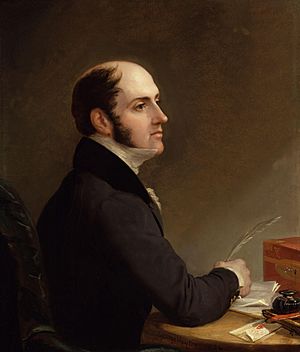
Economy and People
In 1666, Penkridge village had about 212 households, with a total population of around 1,200 to 1,500 people. By 1801, the population was 2,275. It reached its highest point of 3,316 in 1851. After that, the population seemed to stay fairly steady for a century.
Farming was very important. In 1831, about 60% of adult men worked as farmers or farm labourers. Penkridge was also a small but important trading centre, with many shopkeepers and artisans. By 1881, farming still employed about 48% of working men. Many women worked in domestic service. The village also had many inns and people working with carriages, showing its importance as a stop on major routes.
Transport links improved steadily. The main road to Stafford and Wolverhampton was improved in the late 1700s. More coaches started stopping in Penkridge. The Staffordshire and Worcestershire Canal opened in 1772, running right through the village. In 1837, the Grand Junction Railway opened, with Penkridge station built on its west side. The railway crossed the River Penk on the large Penkridge Viaduct.
Some heavy industry developed in the 1700s and 1800s, with ironworks and mills. But this industry declined as larger ironworks grew in the Black Country. The extraction of building materials, like stone and sand, grew in Victorian times.
The Littleton Family's Peak
The Littleton family became even more powerful. In 1749, Sir Edward Littleton bought Penkridge manor, making his family the main landowners. He built Teddesley Hall, a grander home for the family. His great-nephew, Edward Walhouse, inherited the estates and took the name Littleton. He became a very important politician and was made Baron Hatherton.
Lord Hatherton lived at Teddesley and supported education in the area. He paid for schools in Penkridge and Levedale. However, the family's interests began to shift. They owned large estates around Penkridge, but also had valuable coal mines and properties in the growing industrial towns of Cannock and Walsall. These industrial holdings became very profitable, drawing the Littletons' attention away from their farming estates.
The Modern Village
Penkridge in the 20th and 21st centuries has remained a busy market village. It has also become a place where many people live, but its strong ties to farming and the old landowning families have weakened.
Residential areas started growing in Victorian times, with middle-class homes near the railway. The main Stafford-Wolverhampton road was greatly improved between the two World Wars.
During World War II, Teddesley Hall was used for troops and prisoners. The old common lands were used as a military camp. After the war, these areas were developed into a large housing estate, which greatly increased Penkridge's size and population in the 1950s and 1960s. Between 1951 and 1961, the population grew by over 34%.
In the 1900s, the Littleton family began selling off their land. By 1953, much of their land, including Teddesley Hall, was sold. The hall was then torn down.
The M6 motorway was built near Stafford in 1962 and connected to the M1 motorway in 1971.
Today, Penkridge has a large supermarket and many independent shops, cafés, and inns. The area between Pinfold Lane and the river, which used to be for livestock sales, is now a new market place. It attracts many visitors on Wednesdays and Saturdays.
Things to Do in Penkridge
Penkridge has a lively local market on Wednesdays and Saturdays, with up to 100 stalls. There's also an antiques market every Thursday. The tall tower of the Grade I listed Church of St. Michael and All Angels is a famous landmark. Parts of the church date back to the early 1200s. There's also a smaller Methodist church. You can see old buildings from the 1400s and 1500s near the railway station. Penkridge also has its own historical stocks and old jail cells in the village centre.
The village has several pubs and many sports clubs. You can find clubs for cricket, football, rugby union, and tennis.
In late November, the village used to hold a Victorian Night and Christmas Market. This event has now moved to the Market site and has grown to include over 70 stalls and a funfair.
Famous People from Penkridge
- Sir Edward Littleton, 1st Baronet (c.1599 – c.1657) – A 17th-century politician.
- Richard Hurd (1720–1808) – An English writer and Bishop of Worcester.
- Alethea Lewis (1749–1827) – An English novelist known for her Christian themes.
- Sir Lovelace Stamer (1829-1908) – The first Anglican Bishop of Shrewsbury in modern times.
- George Edalji (1876 in Penkridge – 1953) – A solicitor who was wrongly convicted and later pardoned after a campaign supported by Sir Arthur Conan Doyle.
- Rebekah Staton (born 1981) – An English actress, known for narrating Don't Tell The Bride.
- Adam Legzdins (born 1986 in Penkridge) – An English professional footballer and goalkeeper.
Getting Around Penkridge
Penkridge is on the A449 and is located between junctions 12 and 13 of the M6 motorway. You can get there by National Express long-distance buses. Local bus services also connect Penkridge to Cannock and Stafford, and to Wolverhampton.
Penkridge is served by Penkridge railway station on the West Coast Main Line railway. You can also reach the village by the Staffordshire & Worcestershire Canal. Otherton Airfield, home to the Staffordshire Aero club, is also in Penkridge.
Twin Town
Since 1986, Penkridge has been twinned with Ablon-sur-Seine in France.
See also
 In Spanish: Penkridge para niños
In Spanish: Penkridge para niños







